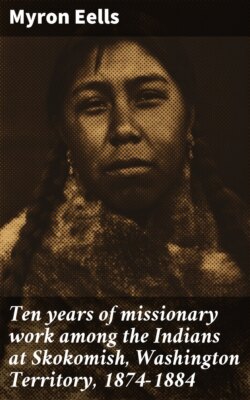Читать книгу Ten years of missionary work among the Indians at Skokomish, Washington Territory, 1874-1884 - Eells Myron - Страница 8
На сайте Литреса книга снята с продажи.
I.
SKOKOMISH.
ОглавлениеTable of Contents
THE Skokomish Reservation is situated in the western part of Washington Territory, near the head of Hood’s Canal, the western branch of Puget Sound. It is at the mouth of the Skokomish River. The name means “the river people,” from kaw, a river, in the Twana language, which in the word has been changed to ko. It is the largest river which empties into Hood’s Canal; hence, that band of the Twana tribe which originally lived here were called the river people. The Twana tribe was formerly composed of three bands: the Du-hlay-lips, who lived fourteen miles farther up the canal, at its extreme head; the Skokomish band, who lived about the mouth of the river, and the Kol-seeds, or Quilcenes, who lived thirty or forty miles farther down the canal. The dialects of these three bands vary slightly.
When the treaty was made by the United States in 1855, the land about the mouth of the Skokomish River was selected as the reservation; the other bands in time moved to it, and the post-office was given the same name; hence, the tribe came to be known more as the Skokomish Indians than by their original name of Tu-án-hu, a name which has been changed by whites to Twana, and so appears in government reports.
The reservation is small, hardly three miles square, comprising about five thousand acres, nearly two thousand of which is excellent bottom land. As much more is hilly and gravelly, and the rest is swamp land. With the exception of the latter, it is covered with timber.
